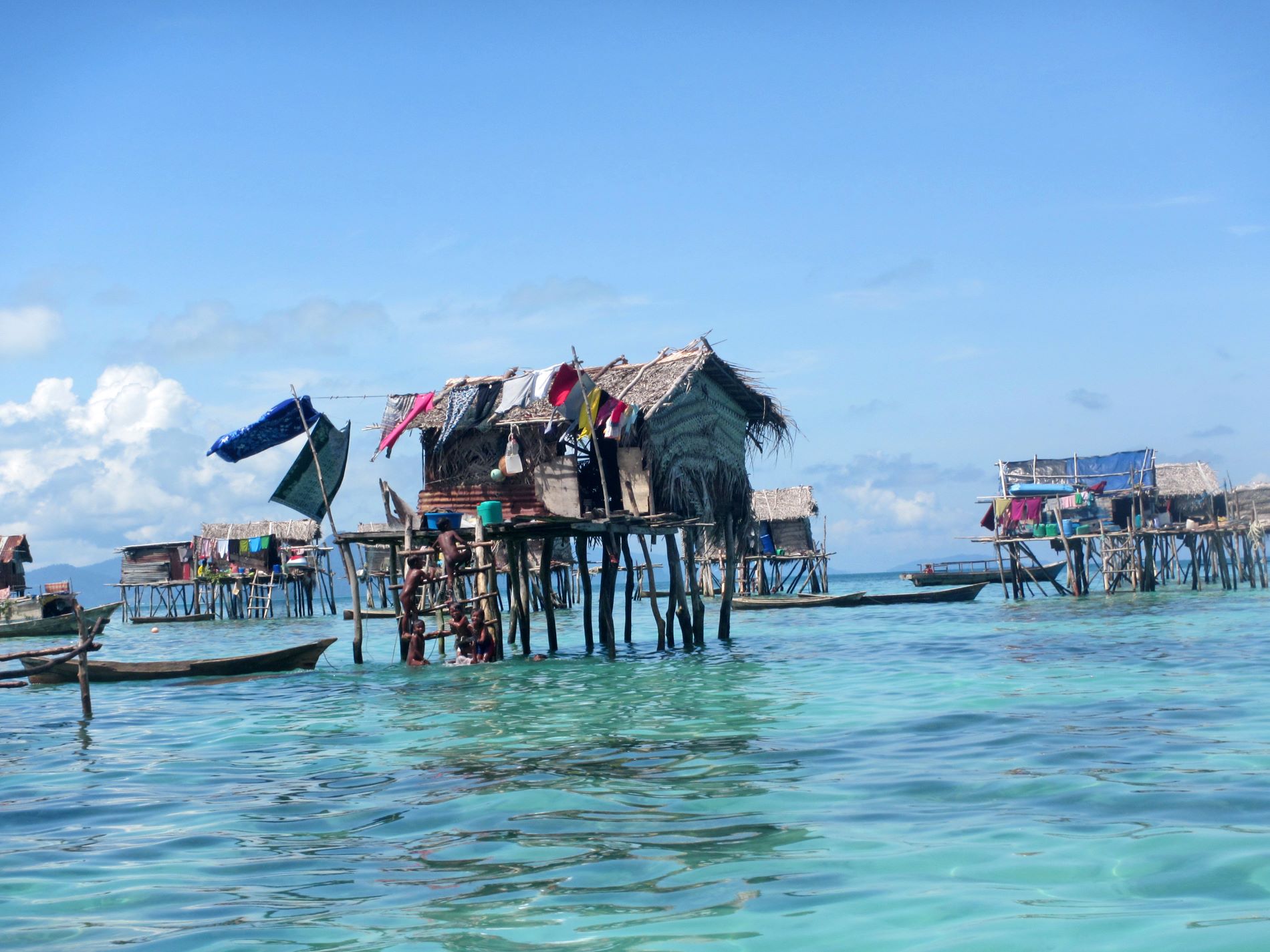Downloads
DOI:
https://doi.org/10.58981/bluepapers.2024.2.10Keywords:
Indigenous culture, sea nomads, marginalized community, oceanic worldview, Sama DilautAbstract
In recent decades in Southeast Asia, dramatic social, economic and political changes have profoundly impacted the lives of Indigenous populations. In Malaysia, the Sama Dilaut, known as the “sea nomads,” are under pressure to abandon their traditional way of living at a time of rapid modernization. Over centuries, the Sama Dilaut have developed a harmonious relationship with their environment, practicing sustainable small-scale fishing methods that have minimal impact on marine ecosystems. In their worldview, humans are not considered exceptional but interconnected with the ocean and species that inhabit it. This contrasts with the Western-centric worldview, where nature-culture dualism prevails, viewing humans as separate from nature and encouraging exploitative attitudes toward the environment. This article outlines and acknowledges the value of the Sama Dilaut culture, knowledge of the sea and struggles against dominant power structures. It advocates for recognizing Indigenous rights to ancestral lands and seas and integrating Indigenous knowledge and communities in conservation practices. These goals are essential for achieving justice for Indigenous peoples and offer significant potential in the search for alternative approaches to combating climate change.
How to Cite
Published
Issue
Section
License
Copyright (c) 2024 Di Fang, Kaiyi Zhu

This work is licensed under a Creative Commons Attribution 4.0 International License.
References
Abrahamsson, Erik. 2011. “Strategies for Maintaining Culture, Identity and Autonomy in Exiled Badjao, a Fishing Population without Fish.” Magister’s thesis, Lund University. https://theaquaticape.org/wp-content/uploads/2010/04/strategies-for-maintaining-culture-identity-and-autonomy-in-exiled-badjao-a-fishing-population-without-fish3.pdf.
Acciaioli, Greg, Helen Brunt and Julian Clifton. 2017. “Foreigners Everywhere, Nationals Nowhere: Exclusion, Irregularity, and Invisibility of Stateless Bajau Laut in Eastern Sabah, Malaysia.” Journal of Immigrant & Refugee Studies 15, no. 3: 232–49. https://doi.org/10.1080/15562948.2017.1319526.
Alamia, Laisa M. 2005. The Sea Nomads of the Philippines: On the Verge of Extinction? United Nations Office of High Commission on Human Rights. www2.ohchr.org/english/issues/minorities/docs/Lumah_3a.doc.
Blust, Robert A. 2007. “The Linguistic Position of Sama-Bajaw.” Studies in Philippine Languages and Cultures 15: 73–114. https://www.sil.org/resources/archives/25719.
DeLoughrey, Elizabeth M. 2019. “Allegories of the Anthropocene.” Durham, NC: Duke University Press.
Gilroy, Paul. 1993. The Black Atlantic: Modernity and Double Consciousness. Cambridge, MA: Harvard University Press.
Hau’ofa, Epeli. 1993. “Our Sea of Islands.” A New Oceania: Rediscovering Our Sea of Islands, edited by Eric Waddell, Vijay Naidu and Epeli Hau’ofa, 2–16. Suva, Fiji: University of the South Pacific.
Hussin, Hanafi, and M.C.M. Santamaria. 2008. “Dancing with the Ghosts of the Sea: Experiencing the Pagkanduli Ritual of the Sama Dilaut (Bajau Laut) in Sikulan, Tawi-Tawi, Southern Philippines.” JATI – Journal of Southeast Asian Studies 13: 159–72.
Jubilado, Rodney C., Hanafi Hussin and Maria K. Manueli. 2011. “The Sama-Bajaus of Sulu-Sulawesi Seas: Perspectives from Linguistics and Culture.” JATI – Journal of Southeast Asian Studies 15: 83–95.
Jumala. Francis C. 2011. “From Moorage to Village: A Glimpse of the Changing Lives of the Sama Dilaut.” Philippine Quarterly of Culture and Society 39, no. 2: 87–131. https://www.jstor.org/stable/23719000.
Kimmerer, Robin Wall. 2013. Braiding Sweetgrass: Indigenous Wisdom, Scientific Knowledge and the Teachings of Plants. Minneapolis, MN: Milkweed Editions.
Latiff, Rozanna. 2024. “Malaysia Defends Eviction of Sea Nomads, Citing Security Concerns.” Reuters, Asia Pacific, June 8. https://www.reuters.com/world/asia-pacific/malaysia-defends-eviction-sea-nomads-citing-security-concerns-2024-06-08/.
Nimmo, H. Arlo. 2006. Magosaha: An Ethnography of the Tawi-Tawi Sama Dilaut. Honolulu: University of Hawaii Press.
Pallesen, A. Kemp. 1985. “Culture Contact and Language Convergence.” Linguistic Society of the Philippines, Special Monograph Issue 24. Manila: Linguistic Society of the Philippines.
Pannell, Sandra. 1996. “Homo Nullius or ‘Where Have All the People Gone?’ Refiguring Marine Management and Conservation Approaches.” Australian Journal of Anthropology 7, no. 1: 21–42. https://www.google.com/url?q=https://doi.org/10.1111/j.1835-9310.1996.tb00335.x&sa=D&source=editors&ust=1730129760305007&usg=AOvVaw2u84Bg4PCqQv1TbiON2fXf.
Reed, Graeme, Nicolas D. Brunet, Deborah McGregor, Curtis Scurr, Tonio Sadik, Jamie Lavigne and Sheri Longboat. 2024. “There is no Word for ‘Nature’ in our Language: Rethinking Nature-Based Solutions from the Perspective of Indigenous Peoples located in Canada.” Climatic Change 177, no. 32. https://doi.org/10.1007/s10584-024-03682-w.
Sather, Clifford. 1997. The Bajau Laut: Adaptation, History, and Fate in a Maritime Fishing Society of South-eastern Sabah. Oxford: Oxford University Press.
–––. 2001. “Bajau Laut Boat-Building in Semporna. ”Techniques and Culture vol. 35–36: 177–98. https://doi.org/10.4000/tc.288.
Schagatay, Erika. 2011. “Review: Predicting Performance in Competitive Apnea Diving. Part III: Depth.” Diving and Hyperbaric Medicine 41, no. 4: 216–28.
Sobrevila, Claudia. 2008. The Role of Indigenous Peoples in Biodiversity Conservation: The Natural but Often Forgotten Partners. Washington, DC: World Bank Group. http://documents.worldbank.org/curated/en/995271468177530126/The-role-of-indigenous-peoples-in-biodiversity-conservation-the-natural-but-often-forgotten-partners.
Solomon, Robert L. 1970. “Boundary Concepts and Practices in Southeast Asia.” World Politics 23, no. 1: 1–23. https://doi.org/10.2307/2009628.
Williams, Raymond. 1976. Keywords: A Vocabulary of Culture and Society. Oxford: Oxford University Press.




